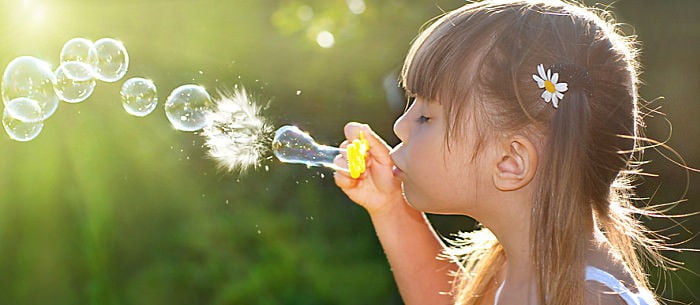
Bubbles:
Bubbles are probably one of our most favorite…most accessible…most portable and…most magical therapy tools in our office. Bubbles can be used in so many ways to promote, practice and help develop essential language skills. With summer (finally) here, it is a perfect time to use bubbles all the time!
Listed below you will find some of our favorite language skills to target using bubbles in conjunction with some easy-to-follow activities.
Using Bubbles to make a requests:
Whether your little one is a talker or not, requests can be made in multiple ways. If your child is NOT a talker, having bubbles in eye sight or at an arms reach for your child, can help to promote opportunities for request through gestures (pointing, eye gaze). These simple gestures aimed at a single object allow you to fill in the blanks for your chld. For example, as they point to or look at the item of interest (bubbles) help validate their attempts by saying, “Oh. You want the bubbles? Let’s play with bubbles!” If your child is a talker, you can expand upon language or target sounds through requesting. So, if a child sees and/or points to the object and says ‘bubbles’ help them by giving them a model for increasing the number of words in their sentence. {Example: Let’s try that again, try saying: ‘I want bubbles’ or ‘can I have the bubbles’ or ‘can we play with bubbles, please’} The number of words expressed will depend upon their age and development.
Using Bubbles to promote Yes or No responses:
Understanding language is a big part of communication that we cannot ignore. Allowing children the opportunity to practice responding to yes/no questions is a way for us to confirm that the child understands what we’re asking as well as understands how we’re going to use the toy/tool. So, asking your child, “Do you want to play with bubbles?” gives them a chance to respond in a way that let’s you (as the parent) know whether or not this is something they want to do. If a child responds with, ‘yes’, you can further use yes/no questions to enforce knowledge of how to play with bubbles. Ask them:
- Should I put the bubbles on my head?
- Should I drink the bubbles?
- Should I throw the bubbles?
- Should I put the bubbles behind my back?
- Should I blow the bubbles?
Appropriate responses gives you insight as to whether or not your child has a basic understanding of how these tools work and how they are intended to be used. If they answer incorrectly, it gives you a chance to teach them the appropriate response.
Using Bubbles to teach turn-taking opportunities:
We love any activity that helps to teach and promote turn-taking skills. It is such a fundamental social rule that children are required to understand throughout their lives. Bubble play is a super fun way to help kids take turns (popping, blowing, chasing, or requesting) in a carefree way. We think it would be ideal to play with bubbles outside, but bath time is another fun time where turn taking can take place by using bubbles.
Using Bubbles to practice a target sound:
If a child has a specific sound they are working to produce bubbles can be a great way to help practice this skill. So as the bubbles are blown, the child can say the sound (ex. /p/) while popping the bubbles. Because you can blow lots of bubbles at once, the opportunity for multiple attempts at production is naturally available.
Using Bubbles to practice a target word/sign:
Similar to practicing target sounds, if a child is working to produce a sound at the word level, have them repeat/read words (3-5) before rewarding them with bubbles. If they’re practicing a sign (like ‘more’), after you blow bubbles, prompt the child by asking them, “Do you want more bubbles? How can you show/ask me?” As the child gets more comfortable and consistent with using sign, prompts may be discontinued. You just have to give enough wait time for the request to be used.
Using Bubbles to practice simple ‘wh’ questions:
Asking ‘wh’ questions is a great one-on-one or group activity that can be facilitated with the use of bubbles. You can ask the child(ren), ‘who is going to blow the bubbles?’; or, ‘where did the bubbles go?’; or, ‘why are there no more bubbles?’; or, ‘when should we pop the bubbles, before we blow them…or after we blow them?’, or ‘there are no more bubbles, what should we do now?’
Using language in a play-based setting helps to facilitate language in a natural way allowing children the opportunity to use language instinctively.